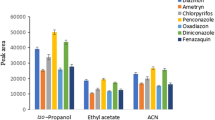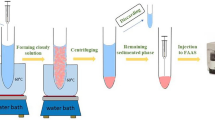Abstract
In the present study, an elevated temperature homogeneous liquid extraction coupled with ionic liquid‑based dispersive liquid–liquid microextraction was developed to extract five carbamate pesticides (pirimicarb, carbaryl, methiocarb, aldicarb, and carbofuran) from packed fruit juice samples. The method consisted of a two-step procedure in which cyclohexylamine was used in order to extract the target analytes. In the first step, the analytes were extracted from a sample solution thermostated at elevated temperature (80 °C) into a water-immiscible organic solvent (cyclohexylamine). In the second step, the separated organic phase was mixed with 1-butyl-3-methylimidazolium chloride (as the solvent for extraction) and the mixture was spread into deionized water. In this step, cyclohexylamine controlled the solubility of 1-butyl-3-methylimidazolium chloride in the aqueous phase and acted as a dispersive solvent and a phase separation agent, simultaneously. After centrifugation, we removed all the gathered organic phases and analyzed them by using high-performance liquid chromatography diode-array detector. Figure of merits of the method including the limits of detection and quantification, enrichment factors, extraction recoveries, and relative standard deviations were obtained within ranges 0.4–3.9 and 1.5–13.2 ng mL−1, 147–217, 59–87%, and 3.3–5.5%, respectively, indicating that the method was successful in determining the analytes.






Similar content being viewed by others
Abbreviations
- EF:
-
Enrichment factor
- DLLME:
-
Dispersive liquid–liquid microextraction
- LOQ:
-
Limit of quantification
- LR:
-
Linear range
- LOD:
-
Limit of detection
- IL:
-
Ionic liquid
- LLE:
-
Liquid–liquid extraction
- ER:
-
Extraction recovery
- RSD:
-
Relative standard deviation
References
Afshar Mogaddam MR, Mohebbi A, Pazhohan A, Khodadadeian F, Farajzadeh MA (2020) Headspace mode of liquid phase microextraction: a review. Trends Anal Chem 110:8–14
Bedendo GC, Jardim ICSF, Carasek E (2012) Multiresidue determination of pesticides in industrial and fresh orange juice by hollow fiber microporous membrane liquid–liquid extraction and detection by liquid chromatography–electrospray-tandem mass spectrometry. Talanta 88:573–580
Chandra Yadav I, Linthoingambi Devi N (2017) Environmental science and engineering: pesticides classification and its impact on human and environment, 6th edn. Studium Press LLC, USA
Chen H, Chen R, Li S (2010) Low-density extraction solvent-based solvent terminated dispersive liquid–liquid microextraction combined with gas chromatography-tandem mass spectrometry for the determination of carbamate pesticides in water samples. J Chromatogr A 1217:1244–1248
Farajzadeh MA, Bamorowat M, Afshar Mogaddam MR (2016) Ringer tablet-based ionic liquid phase microextraction: application in extraction and preconcentration of neonicotinoid insecticides from fruit juice and vegetable samples. Talanta 160:211–216
Farajzadeh MA, Shahedi Hojghan A, Afshar Mogaddam MR (2018) Development of a new temperature-controlled liquid phase microextraction using deep eutectic solvent for extraction and preconcentration of diazinon, metalaxyl, bromopropylate, oxadiazon, and fenazaquin pesticides from fruit juice and vegetable samples followed by gas chromatography-flame ionization detection. J Food Compos Anal 66:90–97
Fernández M, Picó Y, Manes J (2000) Determination of carbamate residues in fruits and vegetables by matrix solid-phase dispersion and liquid chromatography–mass spectrometry. J Chromatogr A 871:43–56
Ghoraba Z, Aibaghi B, Soleymanpour A (2018) Ultrasound-assisted dispersive liquid-liquid microextraction followed by ion mobility spectrometry for the simultaneous determination of bendiocarb and azinphos-ethyl in water, soil, food and beverage samples. Ecotoxicol Environ Saf 165:459–466
http://ec.europa.eu/food/plant/pesticides/eu-pesticides-database (n.d.) EU Pesticides database. Part A of Annex I to Reg. 396/2005
Lachenmeier DW, Nerlich U, Kuballa T (2006) Automated determination of ethyl carbamate in stone-fruit spirits using headspace solid-phase microextraction and gas chromatography–tandem mass spectrometry. J Chromatogr A 1108:116–120
Leça JM, Pereira V, Pereira AC, Marques JC (2014) Rapid and sensitive methodology for determination of ethyl carbamate in fortified wines using microextraction by packed sorbent and gas chromatography with mass spectrometric detection. Anal Chim Acta 811:29–35
Llompart M, Celeiro M, García-Jares C, Dagnac T (2019) Environmental applications of solid-phase microextraction. Trends Anal Chem 112:1–12
Mitra S (2003) Sample preparation techniques in analytical chemistry, First edn. Wiley, London
Mohebbi A, Yaripour S, Farajzadeh MA, Afshar Mogaddam MR (2018) Combination of dispersive solid phase extraction and deep eutectic solvent–based air–assisted liquid–liquid microextraction followed by gas chromatography–mass spectrometry as an efficient analytical method for the quantification of some tricyclic antidepressant drugs in biological fluids. J Chromatogr A 1571:84–93
Moreno-González D, Huertas-Pérez JF, García-Campaña AM, Bosque-Sendra JM, Gámiz-Gracia L (2013) Ultrasound-assisted surfactant-enhanced emulsification microextraction for the determination of carbamates in wines by ultra-high performance liquid chromatography–tandem mass spectrometry. J Chromatogr A 1315:1–7
Msagati TA, Mamba BB (2012) Monitoring of N-methyl carbamate pesticide residues in water using hollow fiber supported liquid membrane and solid phase extraction. Phys Chem Earth A/B/C 50:149–156
Rezaee M, Assadi Y, Milani Hosseini MR, Aghaee E, Ahmadi F, Berijani S (2006) Determination of organic compounds in water using dispersive liquid–liquid microextraction. J Chromatogr A 1116:1–9
Salvatierra-stamp V, Muñiz-Valencia R, Jurado JM, Ceballos-Magaña SG (2018) Hollow fiber liquid phase microextraction combined with liquid chromatography-tandem mass spectrometry for the analysis of emerging contaminants in water samples. Microchem J 140:87–95
Santalad A, Zhou L, Shang F, Fitzpatrick D, Luong JHT (2010) Micellar electrokinetic chromatography with amperometric detection and off-line solid-phase extraction for analysis of carbamate insecticides. J Chromatogr A 1217:5288–5297
Solé S, Merkoçi A, Alegret S (2003) Determination of toxic substances based on enzyme inhibition. Part I. Electrochemical biosensors for the determination of pesticides using batch procedures. Crit Rev Anal Chem 33:89–126
Tang S, Qi T, Dim Ansah P, Nalouzebi Fouemina JC, Kee Lee H (2018) Single-drop microextraction. Trends Anal Chem 108:306–313
Unsal YE, Soylak M, Tuzen M (2015) Ultrasound-assisted ionic liquid-based dispersive liquid-liquid microextraction for preconcentration of patent blue V and its determination in food samples by UV-visible spectrophotometery. Environ Monit Assess 187:203–210
Unsal YE, Soylak M, Tuzen M (2019) Ultrasound-assisted ionic liquid-dispersive liquid-liquid of curcumin in food samples microextraction and its determination. J AOAC Int 102:217–221
Wang S, Yu C, Wang J (2005) Enzyme immunoassay for the determination of carbaryl residues in agricultural products. Food Addit Contam 22:735–742
Wang Q, Chen R, Shatner W, Cao Y, Bai Y (2019) State-of-the-art on the technique of dispersive liquid-liquid microextraction. Ultrason Sonochem 51:369–377
Wasim Aktar M, Sengupta D, Chowdhury A (2009) Impact of pesticides use in agriculture: their benefits and hazards. Interdiscip Toxicol 2:1–12
Wu Q, Chang Q, Wu C, Rao H, Wang Z (2010) Ultrasound-assisted surfactant-enhanced emulsification microextraction for the determination of carbamate pesticides in water samples by high performance liquid chromatography. J Chromatogr A 1217:1773–1778
Yelmaz E, Soylak M (2013) Ionic liquid-linked dual magnetic microextraction of lead(II) from environmental samples prior to its micro-sampling flame atomic absorption spectrometric determination. Talanta 116:882–886
Yongnian N, Qiu P, Kokot S (2005) Simultaneous voltammetric determination of four carbamate pesticides with the use of chemometrics. Anal Chim Acta 537:321–330
Zhang J, Kee Lee H (2006) Application of liquid-phase microextraction and on-column derivatization combined with gas chromatography–mass spectrometry to the determination of carbamate pesticides. J Chromatogr A 1117:31–37
Zhao G, Song S, Wang C, Wu Q, Wang Z (2011) Solid-phase microextraction with a novel graphene-coated fiber coupled with high-performance liquid chromatography for the determination of some carbamates in water samples. Anal Methods 3:2929–2935
Zhou Q, Fang Z (2015) Graphene-modified TiO2 nano tube arrays as an adsorbent in micro-solid phase extraction for determination of carbamate pesticides in water samples. Anal Chim Acta 869:43–49
Acknowledgments
The authors thank the Research Council of the Tabriz University of Medical Science for financial support as grant No. 623110 with ethical code of IR.TBZMED.REC.1396.872.
Funding
Mohammadali Torbati has received research grants from the Tabriz University of Medical Science.
Author information
Authors and Affiliations
Corresponding authors
Ethics declarations
Conflict of Interest
Sanaz Ahmadzadeh Anvar declares that she has no conflict of interest. Mohammadali Torbati declares that he has no conflict of interest. Mir Ali Farajzadeh declares that he has no conflict of interest. Mohammad Reza Afshar Mogaddam declares that he has no conflict of interest.
Ethical Approval
This article does not contain any studies with human or animal subjects.
Informed Consent
Not applicable.
Additional information
Publisher’s Note
Springer Nature remains neutral with regard to jurisdictional claims in published maps and institutional affiliations.
Rights and permissions
About this article
Cite this article
Ahmadzadeh Anvar, S., Torbati, M., Farajzadeh, M.A. et al. Elevated Temperature Homogeneous Liquid Phase Extraction Coupled to Ionic Liquid–Based Dispersive Liquid–Liquid Microextraction Followed by High-Performance Liquid Chromatography: Application of Water-Miscible Ionic Liquids as Extraction Solvent in Determination of Carbamate Pesticides. Food Anal. Methods 13, 1282–1291 (2020). https://doi.org/10.1007/s12161-020-01742-2
Received:
Accepted:
Published:
Issue Date:
DOI: https://doi.org/10.1007/s12161-020-01742-2




